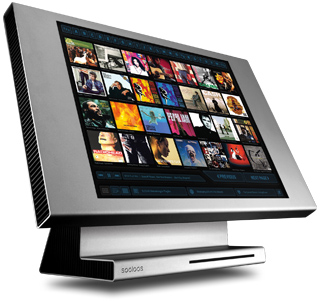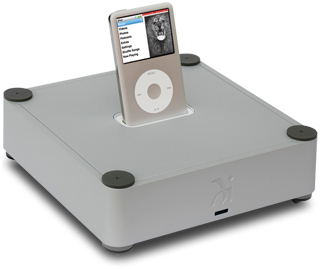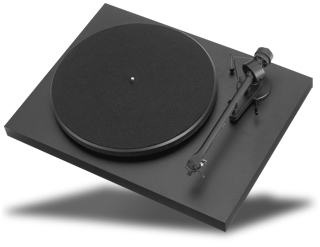Things to Come, Part One: Digital and
Analog Sources
Last month, I was at the CEDIA Expo in Denver,
Colorado, doing on-the-spot
show coverage for the entire SoundStage! Network. Years ago, the annual Expo of the
Custom Electronic & Design Installation Association (CEDIA) was mostly about
custom-installation gear: in-wall speakers and wiring and the like. You didn’t find
much standalone two-channel gear. But as the Expo grew, so, too, did the diversity of the
exhibitors. Today’s CEDIA Expo is the launching pad not only for new custom-install
products, but for new standalone home-theater and two-channel audio gear as well. Along
with the annual Consumer Electronics Show (CES), held in January in Las Vegas, the CEDIA
Expo is a barometer of things to come -- the types of products that consumers can expect
to see in stores from now to sometime in the near future. This first of two articles will
focus on what seems to me are the key trends in digital and analog music sources that will
appeal to two-channel music enthusiasts, and what I think about them.
When it comes to "hard" digital formats,
it’s clear that the Compact Disc still reigns supreme. It’s also clear that the
CD is dying, even in the absence of no other physical format to replace it. DVD-Audio was
nowhere to be found at this year’s Expo -- that format is as dead in the world of
high-resolution audio as HD DVD is in hi-rez video. And while Sony, McIntosh, and Mark
Levinson all introduced new SACD players, it’s pretty clear that that format, too, is
going south. The end of the digital audio disc is near.
In my opinion, that’s not necessarily a bad thing;
with improvements in technology, there are now better ways to distribute and store
digitally encoded music than there were in the early 1980s, when the Compact Disc was
introduced. Downloading is the most practical way to get new music, and music-serving
systems -- whether a dedicated system such as I’ll describe below, or a computer --
are where there’s going to be explosive growth.
 In the category of dedicated
music-serving systems, Sooloos seems to rule the roost in terms of quality and
convenience, although at about $8000 USD for an entry-level setup, Sooloos gear is still
too expensive for most people to consider seriously. For budget-minded audiophiles, a
decent laptop running iTunes or something similar into a high-quality digital-to-analog
converter (DAC) seems the best way to get into music serving. But for those who can afford
a Sooloos rig, this intuitive, well-thought-out system not only handles music files, but
photos and videos as well. As the demand for music servers grows, this kind of quality and
convenience will get less expensive, and more people will be able to afford it. It’s
systems such as these that make very clear why the CD is rapidly becoming a thing of the
past. In the category of dedicated
music-serving systems, Sooloos seems to rule the roost in terms of quality and
convenience, although at about $8000 USD for an entry-level setup, Sooloos gear is still
too expensive for most people to consider seriously. For budget-minded audiophiles, a
decent laptop running iTunes or something similar into a high-quality digital-to-analog
converter (DAC) seems the best way to get into music serving. But for those who can afford
a Sooloos rig, this intuitive, well-thought-out system not only handles music files, but
photos and videos as well. As the demand for music servers grows, this kind of quality and
convenience will get less expensive, and more people will be able to afford it. It’s
systems such as these that make very clear why the CD is rapidly becoming a thing of the
past.
Of course, no discussion of digital music can be had
without mentioning the Apple iPod. Though sales of CDs and CD players are down, and though
the music-server market is growing and the LP is making a resurgence (see below), none of
this compares to the dominance of the iPod and the influence it continues to have on
today’s music-buying and -listening public. It’s now to the point where it seems
as if almost everyone has an iPod, or maybe even two.
But despite the iPod’s ability to store and play
uncompressed digital files, it has yet to become the darling of the audiophile world.
That’s because, until now, every iPod dock and other hookup gadget or accessory that
allows you to connect an iPod to an audio system has been able to extract from it only analog
signals, meaning that you’re at the mercy of the iPod’s built-in DAC.
Audiophiles have long known that they could get improved performance by using an external
DAC, if only the iPod had a digital output, and so have long yearned for a digital dock.
This year, they got it.
 Wadia’s 170iTransport ($379) is
a dock that can extract a digital signal from an unmodified iPod. Users can then hook up
their own DACs and, finally, use an iPod as a high-performance digital source. The
170iTransport also allows pass-through of the analog signal if you want to still use your
iPod that way, and can extract S-video or component-video signals as well, depending on
your player (older iPods support only S-video; newer ones support component video as
well), allowing you to display videos loaded on your iPod on an external screen. Although
Wadia has the first-mover advantage with the 170iTransport, I believe that other companies
will soon follow suit. Wadia’s 170iTransport ($379) is
a dock that can extract a digital signal from an unmodified iPod. Users can then hook up
their own DACs and, finally, use an iPod as a high-performance digital source. The
170iTransport also allows pass-through of the analog signal if you want to still use your
iPod that way, and can extract S-video or component-video signals as well, depending on
your player (older iPods support only S-video; newer ones support component video as
well), allowing you to display videos loaded on your iPod on an external screen. Although
Wadia has the first-mover advantage with the 170iTransport, I believe that other companies
will soon follow suit.
Probably the most surprising thing going on today with
music sources isn’t what’s happening with digital, but what’s happening
with analog. The resurgence of the 60-year-old LP has made headlines everywhere, and the
proof, too, is ubiquitous: record companies that had long ago stopped making LPs are
releasing more and more vinyl to stores, and more turntables from more manufacturers are
now available to consumers than have been for years.
 The dominant turntable maker these days
appears to be Austria-based Pro-Ject, represented at CEDIA Expo by their US distributor,
Sumiko. Pro-Ject offers a full range of turntables, from the affordable to the
high-priced, to appeal to almost any audiophile’s budget. I also hear that Pro-Ject
makes turntables for many other well-known brands. They seem to be doing very well.
At the Expo, Japan’s TEAC was showing inexpensive, "console"-type
turntables with retro styling. These days, you can get almost any kind of turntable you
want. The dominant turntable maker these days
appears to be Austria-based Pro-Ject, represented at CEDIA Expo by their US distributor,
Sumiko. Pro-Ject offers a full range of turntables, from the affordable to the
high-priced, to appeal to almost any audiophile’s budget. I also hear that Pro-Ject
makes turntables for many other well-known brands. They seem to be doing very well.
At the Expo, Japan’s TEAC was showing inexpensive, "console"-type
turntables with retro styling. These days, you can get almost any kind of turntable you
want.
What was most interesting to me was seeing strong evidence
at the Expo that it’s not only turntable makers who know that LPs will be around for
a while: other, non-turntable-making companies recognize the resurgence of vinyl and are
creating products to accommodate it. Anthem introduced their new 225 integrated amplifier
($1499), which comes with a built-in moving-magnet phono stage. To me, this is something
to write home about; most companies started dropping phono stages from their integrated
amps and preamps at least 15 years ago, when it seemed clear that CDs were going to wipe
LPs off the face of the earth. To see a company like Anthem, whose Statement D2 processor
is at the forefront of digital processing, include a phono stage in their newest
entry-level integrated, makes me think that there might now be a good chance that the LP
will outlast the CD!
These are the trends I see in digital and analog music
sources. Next month, I’ll write about what I see happening in amplification. By then
I’ll have attended the Rocky Mountain Audio Fest (October 10-12), also in Denver;
that article will include conclusions drawn from what I saw at both events. Stay tuned.
. . . Doug Schneider
E-mail comments to the editor@goodsound.com.
|